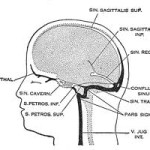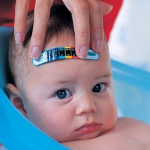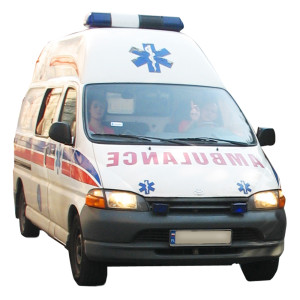Three cheers for our heroic Lifeguards! In this episode, I get the opportunity to speak with Logan Evans, the Life Guard who was part of a three person team of First Aid providers who helped a woman who had apparently had a seizure and fallen in the Women’s shower room at a local pool! The problem was that there was a pool full of people and the patient was trapped in a locked shower stall half in and half out of the door on the ground. Watch this interview to see how Logan, Certified Lifeguard, sprung into action to help this person through this scary and potentially life threatening situation.
Tag Archives: seizure
What Is Cerebral Venous Sinus Thrombosis?
Hello Rescuers!
I received an email from a RoyOnRescue friend who had suffered a head injury while playing a sport. After being seen by the doctor he was diagnosed with Cerebral Venous Sinus Thrombosis or (CVST). He had asked me if I would give my explanation of what it is and if it was something he should be worried about. His doctor had ex plained it but he was still a bit foggy regarding the diagnosis. Well, after looking into it from the clinical perspective, I realized that it was a pretty big deal and in some cases may be fatal. I researched multiple sources to gather credible information and when it all came down to brass tacks, I found that the Wikipedia explanation had done a pretty dog-gone good job of summarizing CSVT. So, with all credit given to them for most of this article and a link back to their website, here it is.
plained it but he was still a bit foggy regarding the diagnosis. Well, after looking into it from the clinical perspective, I realized that it was a pretty big deal and in some cases may be fatal. I researched multiple sources to gather credible information and when it all came down to brass tacks, I found that the Wikipedia explanation had done a pretty dog-gone good job of summarizing CSVT. So, with all credit given to them for most of this article and a link back to their website, here it is.
I have personally responded and treated many different types of head injuries as a paramedic but had not researched this problem to this level. Then, shortly after receiving this question, I read that Secretary of State, Hillary Clinton was diagnosed and hospitalized with the very same problem secondary to her head injury! Ironic. So, I thought to myself, if two people experienced this problem secondary to a common traumatic head injury(concussion), there may be more with the same question.
Here’s my trimmed-down version of what it is, what it’s symptoms are, how to determine if it is truly CSVT and then what a person may want to do if they think they may be suffering from such a complication. So let’s dig into some of the questions you may have! P.S. You’ll notice there are more links then usual in this article. The topic is so complex and has so many different facets I thought it wise to allow you to do some of your own information mining and hope the links make it easier.
Q: What is a cerebral venous sinus thrombosis anyway?
A: A CVST is the presence of thrombosis (a blood clot) in the dural venous sinuses, which drain blood from the brain.
Q: What causes a CVST?
A: There can be many causes of CVST. Here is a few I included:
- Thrombophilia, a tendency to develop blood clots due to abnormalities in coagulation, e.g. factor V Leiden, deficiency of protein C, protein S or antithrombin, or related problems
- Nephrotic syndrome, a kidney problem causing protein loss in the urine
- Chronic inflammatory diseases, such as inflammatory bowel disease, lupus and Behçet’s disease
- Pregnancy and puerperium (the period after giving birth)
- Particular blood disorders, especially polycythemia vera and paroxysmal nocturnal hemoglobinuria
- Use of estrogen-containing forms of hormonal contraception
- Meningitis and infections of the ear, nose and throat area such as mastoiditis and sinusitis
- Direct injury to the venous sinuses
- Medical procedures in the head and neck area
- Sickle cell anemia
- Dehydration, primarily in infants and children
- Homocystinuria
Q: How might I know if I have a CVST?
A: Headache that may worsen over the period of several days, but may also develop suddenly. Strangely the headache may be the only symptom of cerebral venous sinus thrombosis. Stroke, 40% of all patients have seizures, Common symptoms in the elderly with this condition are otherwise unexplained changes in mental status and a depressed level of consciousness. The pressure around the brain may rise, causing papilledema (swelling of the optic disc) which may be experienced as visual problems. In severely raised intracranial pressure, the level of consciousness is decreased, the blood pressure rises, the heart rate falls. This is a common symptom found in closed head injuries which makes sense as the mechanism is very similar.
Q: How will the doctor know if this is what I have?
A: The most commonly used tests are computed tomography (CT) and magnetic resonance imaging (MRI), both using various types of radiocontrast to perform a venogram and visualise the veins around the brain
Q: How is a CVST treated and cured?
A: Treatment is with anticoagulants (medication that suppresses blood clotting), and rarely thrombolysis (enzymatic destruction of the blood clot). Given that there is usually an underlying cause for the disease, tests may be performed to look for these. The disease may be complicated by raised intracranial pressure, which may warrant surgical intervention such as the placement of a shunt.
A: Yes. Like any illness or injury that causes a problem with the circulation of oxygenated blood to our tissues, this type of problem can be very dangerous if left untreated. It also runs a risk of complication in that it raises the intracranial pressures which can act similar to a closed head injury and this too can cause severe injury or death. If a person has any of the symptoms listed above, they should be seen as soon as possible to rule out this potentially life threatening disorder. If a person is reacting with decreased level of consciousness, or any type of life threatening complications, activation of Emergency Medical Services or 911 should be immediate with life saving or time buying intervention given.
I hope this helps and keep well!
See Source:
http://en.wikipedia.org/wiki/Cerebral_venous_sinus_thrombosis
http://neurology.jwatch.org/cgi/content/full/2007/515/2
http://www.medscape.com/viewarticle/705510_3
My Baby Is Having A Seizure, What Do I Do?
Hello Everyone!
I received a question regarding infants having seizures and the proper treatment for them. 
The person asked if it’s proper to handle the patient the same as an adult? This is a great question and one I wanted to address a little more in depth than a simple reply by email.
First, it’s important to understand what a seizure is. The following is a quote by physician, Dr. Fawn Leigh from Duke Health who did a great job describing the two different categories of seizures and how they manifest themselves.
Click here to see the complete article located at: http://www.dukehealth.org/health_library/advice_from_doctors/your_childs_health/childhoodseizures
“Seizures are divided into two major categories (based on 1981 international classification):
- Generalized seizures affect the whole brain or both hemispheres of the brain
- Partial seizures, also known as focal seizures, affect one part or one side of the brain
Generalized Seizures
Generalized seizures are divided into convulsive and nonconvulsive. Convulsive means that there is muscle movement such as stiffening (also known as tonic) or jerking (clonic) activity. When these movements are combined it may be called “grand mal.”
Other types of convulsive seizure activity include myoclonic and atonic seizure activity. Myoclonus is usually characterized by sudden, single jerks. Atonic seizure activity is typically characterized by dropping quickly to the floor as if suddenly asleep or paralyzed. The child then quickly recovers.
These two latter convulsive seizure types can both be difficult to diagnose and treat because often they are the manifestation of a mixed seizure disorder. In infants these seizures may be called infantile spasms.
Nonconvulsive means that there is alteration of consciousness without muscle movement. This form of seizure activity was formerly called “petit mal,” and is now commonly referred to as “absence.”
Absence seizures are unique in that typically they are characterized by an abrupt onset of staring and end just as abruptly with no confused state following the events. Parents usually report that the child looks like they are “spacing out.” (Teenagers who look like this often are not having seizures — they are simply bored.)
Partial Seizures
Partial seizures can be simple or complex. Simple partial seizures are focal seizures that involve movement or sensation on one side of the body without altered consciousness. Simple partial seizures are commonly localized to areas in the brain called the motor or sensory strip.
Partial seizures may be with or without aura, which involves associated states such as fear, or changes in heart rate, flushing, or abdominal discomfort.
Complex partial seizures commonly originate from the frontal and temporal lobes of the brain where there are many complex interconnections, resulting in alteration of conscious. Typical complex partial seizures manifest as sudden change in level of alertness with or without aura, blank stare, confusional state, or aimless movements such as wandering around or repetitive behavior.”
Second, it’s important to understand what the main cuases of seizures are:
- Fever
- Infection such as meningitis
- Trauma
- Hemorrhage
- Brain malformations
- Brain dysmaturity
- Genetic disorder
Thirdly, when it comes to treating an infant compared to an adult, it’s a bit easier, though not any less intense especially if it’s your child. It’s physically easier because baby is smaller and easier to manage.
If this seizure is with a child who has never had a seizure before, 911 or Emergency Medical Services should be activated. The rescuer is going to follow National and International guidelines for treating a seizure patient. Protect the baby from hurting itself while seizing. If it’s in a bath tub, drain the bath tub of water so as to reduce the risk of drowning and then protect the child from hurting itself while seizing. Nothing should be put into it’s mouth which is old school for seizure management in trying to prevent “swallowing the tongue” or biting the tongue off. It is also important that we not try and prevent the baby’s body from convulsing by holding it still or wrapping them tightly. Simply protect it’s head and other parts of it’s body from hitting anything during the convulsive stage of the seizure. After the seizure is over, the baby will usually go into a post seizure phase called the “postictal” phase, and there may be some frothy sputum(spit) around the baby’s mouth or in its nose. A bulb syringe normally used for suctioning mucous or sinus congestion could be used to suction or clear the baby’s nasal passage but it is probably not as necessary as we’d like to think. As a general rule, baby’s have a great gag reflex and if they have any mucous or sputum in their upper airway, it will probably be coughed clear. If the baby begins to breath after the seizure, it could be irregular with some grunting for a short time and then increasingly get more normal. Skin color if it has changed during the seizure to a dusky, purple or blue color should improve as the baby begins breathing more normal and it is perfectly acceptable to comfort the baby in a natural position while maintaining a neutral airway in order for it to recover from the seizure.
If it does not begin breathing, begin basic cardiac life support according to the latest ECC/ILCOR and American Heart Association guidelines. Courtesy of ProFirstAid.com, a Free Online infant CPR training video is available by clicking here!
As many as 2-5% of all children will experience at least one seizure related to a fever over 102 degrees Fahrenheit. The seizure itself is usually harmless and does not cause brain damage nor lead to epilepsy.
Seizures in any age patient can be very scary, and the causes of a seizure are many. Therefore, if it’s the first seizure the person has ever had, we should plan for the worst and hope for the best. This can be done by calling the emergency medical services or 911 depending on your area. Support the patient with basic first aid procedures while waiting for rescuers to arrive and then follow up with your pediatrician after the baby is stable.
If your baby is having a high fever and your afraid that it may cause a febrile seizure, there are some basic steps to help lower your baby’s temperature. Click here to read an article about how to lower a body temperature from a fever.
Well, I hope this helps and I appreciate the great questions so many of you have been asking. Keep them coming and while your waiting for a response, keep on saving lives!
Best Wishes,
Roy
RoyOnRescue.com
royonrescue@gmail.com
What’s A Seizure And How Do I Treat It?
Seizures can be caused by many different things and though they don’t mean that the person has a serious condition, it is important to know what to do during and after a person has one. A student wrote in asking if I could give some additional information about how to handle a person who is having a seizure. Though it seems complicated when you’re watching a seizure in progress, the treatment plan is quite simple.
1. Protect the person while they are having a seizure.
2. If this is the first time this person has ever had a seizure, call 911 or EMS.
3. Treat the patients needs after they stop having a seizure.
4. Wait for EMS to arrive and takeover.
For a detailed training on seizure first aid, go to www.profirstaid.com and click on the video review tab at the top of the page. Then search for the topic of seizures, get your favorite beverage and watch the video training.
Until next time…
Roy
http://www.epilepsyfoundation.org/answerplace/medical/seizures/types/


